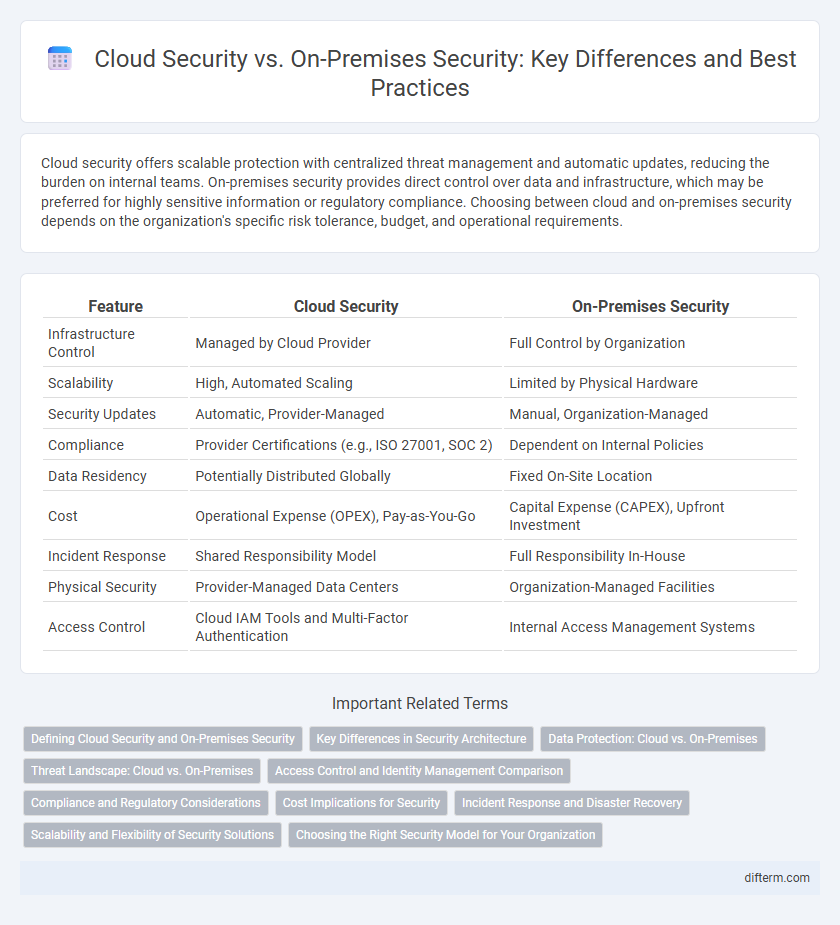Cloud security offers scalable protection with centralized threat management and automatic updates, reducing the burden on internal teams. On-premises security provides direct control over data and infrastructure, which may be preferred for highly sensitive information or regulatory compliance. Choosing between cloud and on-premises security depends on the organization's specific risk tolerance, budget, and operational requirements.
Table of Comparison
| Feature | Cloud Security | On-Premises Security |
|---|---|---|
| Infrastructure Control | Managed by Cloud Provider | Full Control by Organization |
| Scalability | High, Automated Scaling | Limited by Physical Hardware |
| Security Updates | Automatic, Provider-Managed | Manual, Organization-Managed |
| Compliance | Provider Certifications (e.g., ISO 27001, SOC 2) | Dependent on Internal Policies |
| Data Residency | Potentially Distributed Globally | Fixed On-Site Location |
| Cost | Operational Expense (OPEX), Pay-as-You-Go | Capital Expense (CAPEX), Upfront Investment |
| Incident Response | Shared Responsibility Model | Full Responsibility In-House |
| Physical Security | Provider-Managed Data Centers | Organization-Managed Facilities |
| Access Control | Cloud IAM Tools and Multi-Factor Authentication | Internal Access Management Systems |
Defining Cloud Security and On-Premises Security
Cloud security involves protecting data, applications, and infrastructure hosted on remote servers managed by third-party providers, leveraging scalable tools like encryption, identity management, and threat detection. On-premises security refers to safeguarding IT assets physically located within an organization's premises, using firewalls, intrusion detection systems, and physical access controls. Both approaches demand tailored strategies to address specific risks and compliance requirements unique to their environments.
Key Differences in Security Architecture
Cloud security architecture relies on shared responsibility, where cloud providers implement foundational controls like data encryption, identity management, and network security, while customers manage access rights and data governance. On-premises security architecture requires organizations to maintain full control over hardware, software, physical security, and network infrastructure, demanding significant investment in specialized security personnel and technologies. Cloud environments typically offer scalable, automated security measures with continuous monitoring and threat intelligence integration, contrasting the static, manually managed defenses common in on-premises setups.
Data Protection: Cloud vs. On-Premises
Cloud security employs advanced encryption, automated backups, and continuous monitoring to protect data at scale, benefiting from provider expertise and global infrastructure redundancy. On-premises security allows for direct control over physical hardware and data access policies, enabling tailored protection but requiring significant in-house resources and maintenance. Data protection in cloud environments emphasizes scalability and rapid incident response, whereas on-premises setups focus on customized security protocols and compliance with local regulations.
Threat Landscape: Cloud vs. On-Premises
Cloud security faces a more dynamic threat landscape due to its extensive attack surface and constant exposure to internet-based threats, including advanced persistent threats (APTs) and credential theft. On-premises security controls typically rely on physical barriers and localized network defenses, which mitigate risks from external attackers but may lack the scalability to address insider threats and sophisticated malware. The evolving nature of cloud vulnerabilities demands continuous monitoring and adaptive security measures driven by automation and threat intelligence integration.
Access Control and Identity Management Comparison
Cloud security offers dynamic access control and identity management through centralized, scalable platforms like AWS IAM and Azure AD, enabling seamless integration with multi-factor authentication and automated role-based access controls. On-premises security relies on traditional, localized systems such as LDAP and Active Directory, which require manual configuration and maintenance, potentially limiting scalability and real-time threat response. The cloud's advanced analytics and continuous monitoring provide enhanced visibility and faster detection of unauthorized access compared to on-premises environments.
Compliance and Regulatory Considerations
Cloud security frameworks often streamline compliance with global regulations such as GDPR, HIPAA, and PCI DSS by offering standardized, auditable environments and built-in controls. On-premises security requires organizations to independently manage and update their systems to meet evolving regulatory requirements, increasing the complexity and resource demands. Hybrid models combine cloud and on-premises controls, demanding rigorous governance to ensure comprehensive compliance across diverse infrastructures.
Cost Implications for Security
Cloud security often reduces upfront capital expenditures by eliminating the need for physical hardware, shifting to a scalable, pay-as-you-go model that can optimize operational costs. On-premises security requires significant investment in infrastructure, maintenance, and personnel, leading to higher fixed costs and potentially unpredictable expenses due to updates or breaches. Cost implications favor cloud security for organizations seeking flexibility and lower initial investment but demand careful evaluation of long-term expenses associated with data transfer and compliance.
Incident Response and Disaster Recovery
Cloud security offers scalable incident response capabilities through automated threat detection and real-time monitoring, reducing response times significantly compared to traditional on-premises setups. Disaster recovery in cloud environments benefits from geographically distributed data centers, enabling faster backup restoration and minimizing downtime. On-premises security requires substantial investment in dedicated infrastructure and personnel for incident response and disaster recovery, often resulting in slower recovery and higher costs.
Scalability and Flexibility of Security Solutions
Cloud security offers unparalleled scalability, allowing organizations to dynamically adjust resources and security measures based on fluctuating demand, which is often limited in on-premises security systems due to fixed hardware capacity. The flexibility of cloud security solutions enables seamless integration with diverse technologies and rapid deployment of updates, ensuring adaptive defence mechanisms against emerging threats. In contrast, on-premises security requires significant manual intervention and infrastructure upgrades to scale or adapt, leading to potential delays in response and higher operational costs.
Choosing the Right Security Model for Your Organization
Choosing the right security model involves evaluating cloud security's scalability, automated updates, and managed threat detection against on-premises security's control, customization, and compliance capabilities. Organizations with dynamic workloads benefit from cloud security's elasticity and rapid incident response, whereas those with strict data sovereignty requirements may prefer on-premises solutions for direct oversight. A hybrid approach often optimizes protection by combining cloud agility with on-premises control, tailored to organizational risk profiles and compliance mandates.
Cloud security vs on-premises security Infographic

 difterm.com
difterm.com